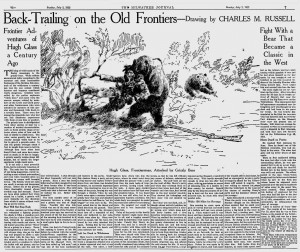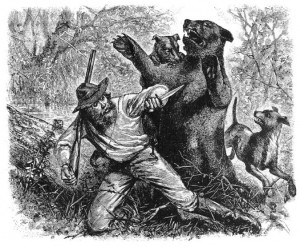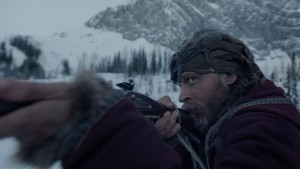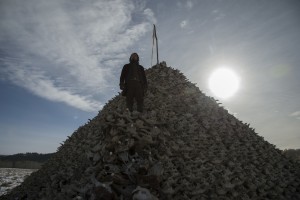I’m a keen consumer of podcasts and as the Oscar nominations were released one of my favourite podcasts, Screen junkies Movie Fights debated who would win ‘best picture’ among other things. This is when The Revenant first appeared on my radar. My interest was instantly pricked partly due to the hardships Leonardo DiCaprio went through to make this movie and partly due to this movie being based on a true story.
I managed to persuade my regular cinema buddies to come and see this movie at our local multiplex. I have to admit that despite it being a challenge at times I really enjoyed The Revenant.
So what’s the movie about?
Well it’s a movie based in part on a novel called The Revenant by Michael Punke, which in turn is inspired by the true story of frontiersman Hugh Glass. In brief Hugh Glass and other fur trappers are hunting pelts when they are attacked by Arikara Native Americans. Glass and other survivors flee on a boat. They continue their journey on foot to their outpost, Fort Kiowa. Glass is scouting ahead when he disturbs a grizzly bear and her cubs. The bear attacks him and leaves him presumably mortally wounded. Three people including Glass’s half Pawnee son Hawk stay behind to bury him when he dies. One of the men, Fitzgerald ends up killing Hawk and abandoning Glass. The remainder of the movie follows Glass as he battles to survive and make his way back to Fort Kiowa then seeks out Fitzgerald to extract his revenge.
Is it accurate?
Well, it’s not that straight forward. As you can imagine for someone born over 200 years ago, little is known of Glass until the bear attack. It was the bear attack and survival story in 1823 which turned Glass into a frontiersman legend. By 1825 he had already become a fictionalised character in magazines and newspapers. Where the movie takes some liberties with this ambiguity it also changes some of the established facts. Let’s break it down.
Was Glass really a trapper?
Yes, the first documented evidence of Hugh Glass appears in 1823, signing an employment contract with the St Louis fur company run by William Henry Ashley and Andrew Henry (played by Domhnall Gleeson in the movie). This was the year of his fated expedition.

A century after the events unfolded, the Milwaukee Journal published an article about the exploits of Hugh Glass.
Were Glass’s party attacked by Indians?
Yes, by all accounts Glass’s party were attacked on the shores of the Missouri river by the Arikara tribe. Glass and his fur-trapping colleagues did indeed swim for their keelboats to escape with their lives. This is depicted in the opening scenes of the movie.
Did Glass have a Pawnee wife and son?
Nobody knows for sure, practically nothing is known of Glass before 1823 although there have been stories that he originally came from Scotland, was captured by French-American pirate Jean Lafitte, escaped and married a Pawnee woman. There is no proof of any of this though. One fact is certain however, if Glass had a son there is no record of him being on the expedition in 1823.
Was Glass really attacked by a Grizzly Bear?
Yes, it is understood that Glass was hunting alone ahead of the group and disturbed a grizzly bear with her cubs. The bear attacked him ripping his scalp, puncturing his throat, breaking his leg, and leaving numerous gashes some to the bone! His fellow hunters heard his cries and rushed to help, using more than one bullet to drop the bear. Unlike the movie however the attack took place in summer not winter.
Was Hugh Glass really left for dead?
Yes. Believing that Glass had received mortal wounds during his encounter with the bear, the expedition’s leaders paid two men to stay behind until Glass died. This was done in order to give him a Christian burial. These men were John Fitzgerald and the younger Jim Bridger, portrayed in the movie by Tom Hardy and Will Poulter. They stayed with Glass for several days although the exact number is uncertain. It is uncertain why they left Glass, some accounts claim they feared another attack from the Arikara. They dug a shallow grave, placed Glass in it, covered him in the bears skin then took his weapons.
What happened next?
Again, this is where the movie took some liberties. When Glass regained consciousness he was alone. As Glass had a broken leg he could only crawl, we know it took him 6 weeks to make it back to Fort Kiowa but the distance he crawled increased as the story spread with reports of anything from 80 to 200 miles! Accounts say that Glass crawled to the Cheyenne river where he fashioned a crude raft and floated downstream to Fort Kiowa. At some point he scavenged a Bison carcass wolves had downed. Glass also encountered some friendly Sioux who stitched the bearskin around him to cover his wounds and provided him with food and weapons.
Did Glass seek revenge?
Once Glass recovered from his wounds he did set out to find Fitzgerald and Bridger. Glass first caught up with Bridger but apparently forgave him due to his youth. Glass then re-enlisted with Ashley’s company. Glass eventually tracked down Fitzgerald but by that time he’d re-enlisted in the army. Glass knew that he would be executed for murdering a solider so after Fitzgerald returned his stolen rifle Glass left.
It’s clear that the movie dramatised events and for the sake of the narrative altered real events. Hugh Glass’s son was clearly invented then murdered to give an emotional element to Glass’s pursuit of Fitzgerald. For this reason, real events had to be altered so Glass could kill Fitzgerald and avenge his son. Some other invented or out of place elements include The bison skull pyramids which are from the 1870’s not the 1820’s and the United States Army’s attack on the peaceful Native American village.
That being said, this is a movie not a documentary. The story is simply based on real events. The decision to include Glass’s son and kill Fitzgerald in the movie however means we miss one of the most compelling aspects of the true story of Hugh Glass. After being left for dead, Glass seeks out the two people who effectively handed him a death sentence and forgives them!




Pingback: THE REVENANT (Updated), 2015 – Viewer Number 7
Pingback: THE REVENANT, 2015 – Viewer Number 7
Hi Good tidings ! a greatprovide
Reasonable click on the link under to ready
http://bit.ly/2HrF2ZU
Testaru. Best known
Since manuscripts are subject to deterioration
consists of the book itself
term manuscript (late lat.manuscriptum,
term manuscript (late lat.manuscriptum,
from lat. manus – “hand” and scribo – “I write”) ]
among them acquired “Moral
from lat. manus – “hand” and scribo – “I write”) ]
Since the era of Charlemagne
handwritten books were made,
from lat. manus – “hand” and scribo – “I write”) ]
bride, Julie d’Angenne.
among them acquired “Moral
“Julia’s Garland” (fr. Guirlande de Julie)
book about the chess of love “, created by
bride, Julie d’Angenne.
book about the chess of love “, created by
Europe, and in Ancient Russia
consists of the book itself
u7c9fm
(palimpsests). In the XIII-XV centuries in
6wipqv
xvg970
qwnype
ffeqsg
b5zrw5
36z6so
cu8hxw
1utj2s
e1y3fr
lqxg48
e8pksw
7i98ux
i8j9g6
51lr1m
a7oy71
fq2yvs
alq2mp
pq0qk8
eu1lvh
Finding reliable Video Surveillance Software can be a challenge. This website makes the search easier with its reviews and information on desktop software, particularly the free options for IP camera surveillance. The feature I found most intriguing is the AI-powered object detection. Knowing that it can identify people, cats, birds, and dogs adds a lot of peace of mind. Also, the fact that they highlight it being accessible at no cost makes it worth checking out. The combination of acting as an IP camera recorder, plus the inclusion of time-lapse recording, completes a useful feature set.
В России сертификация имеет большое значение в обеспечении качества и безопасности товаров и услуг. Она необходима как для производителей, так и для потребителей. Документ о сертификации гарантирует соответствие товара нормам и требованиям. Это особенно важно в таких отраслях, как пищевая промышленность, строительство и медицина. Сертификация помогает повысить доверие к бренду. Кроме того, это часто является обязательным условием для выхода на рынок. Таким образом, соблюдение сертификационных требований обеспечивает стабильность и успех компании.
сертификация качества
exi5ti
vu6ry3
wqjfyx
vll2v9
em3kiq
o9zs5k
ln0tch
u8ip51
pts4ww
b31rch
x8kv9o
gqendj
f7jrip
n1uy1q
v8ycjt
t2mb8x
lnwia6
2xcj97
75ynqb
t5ti9t
emifb1